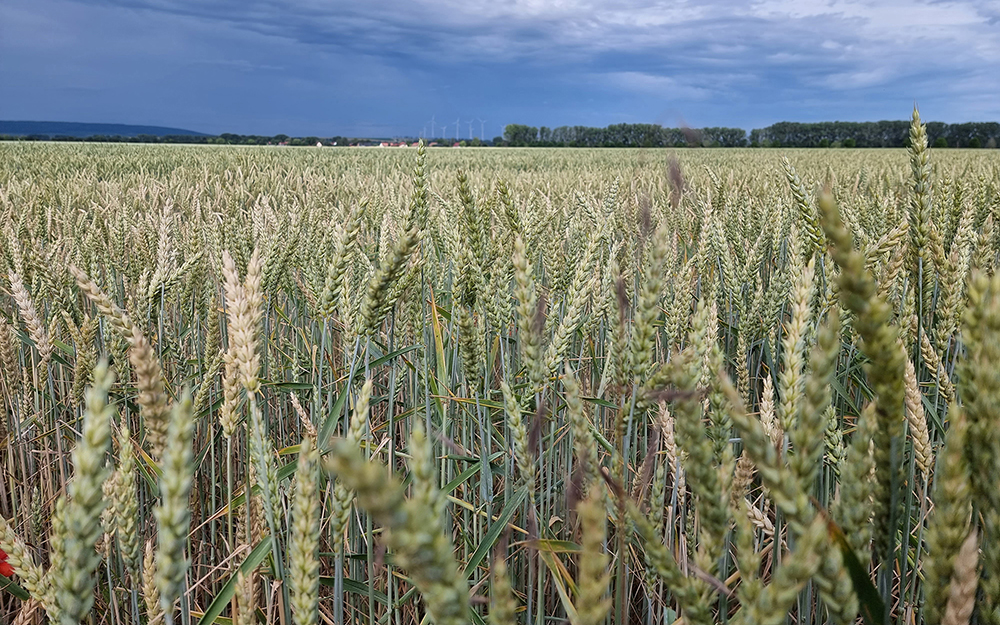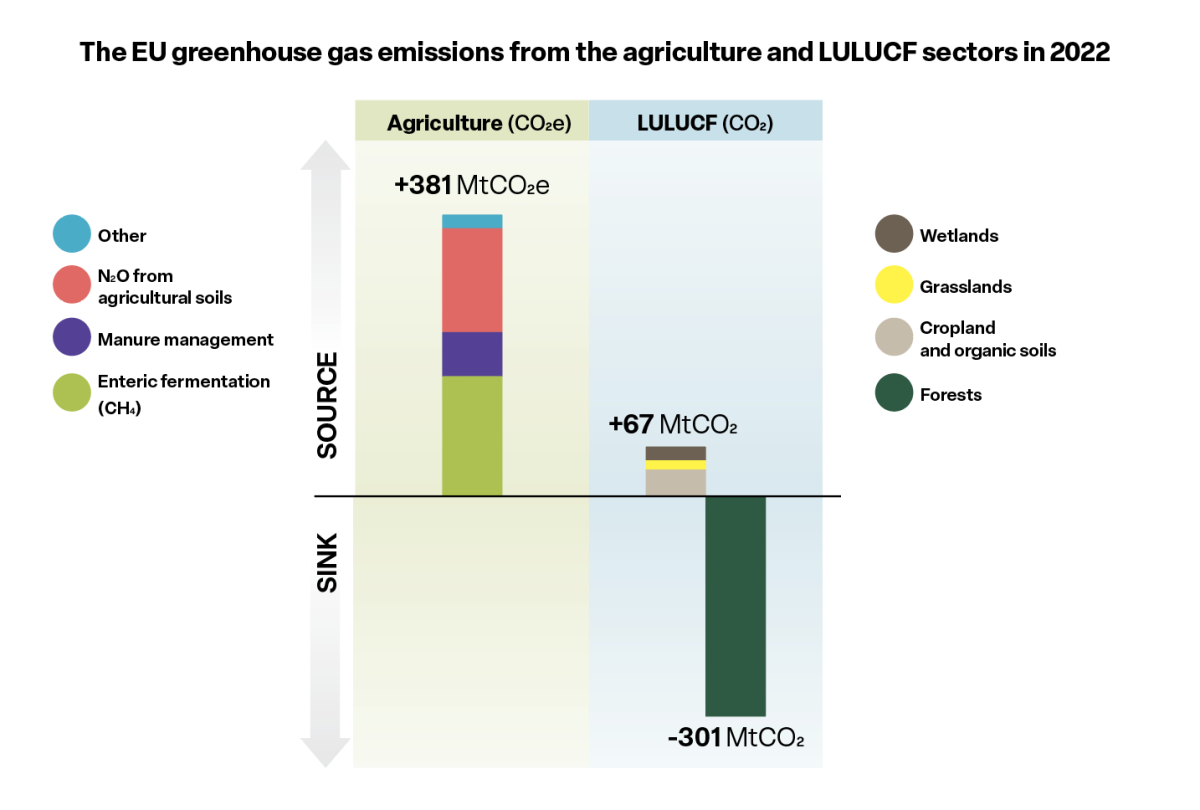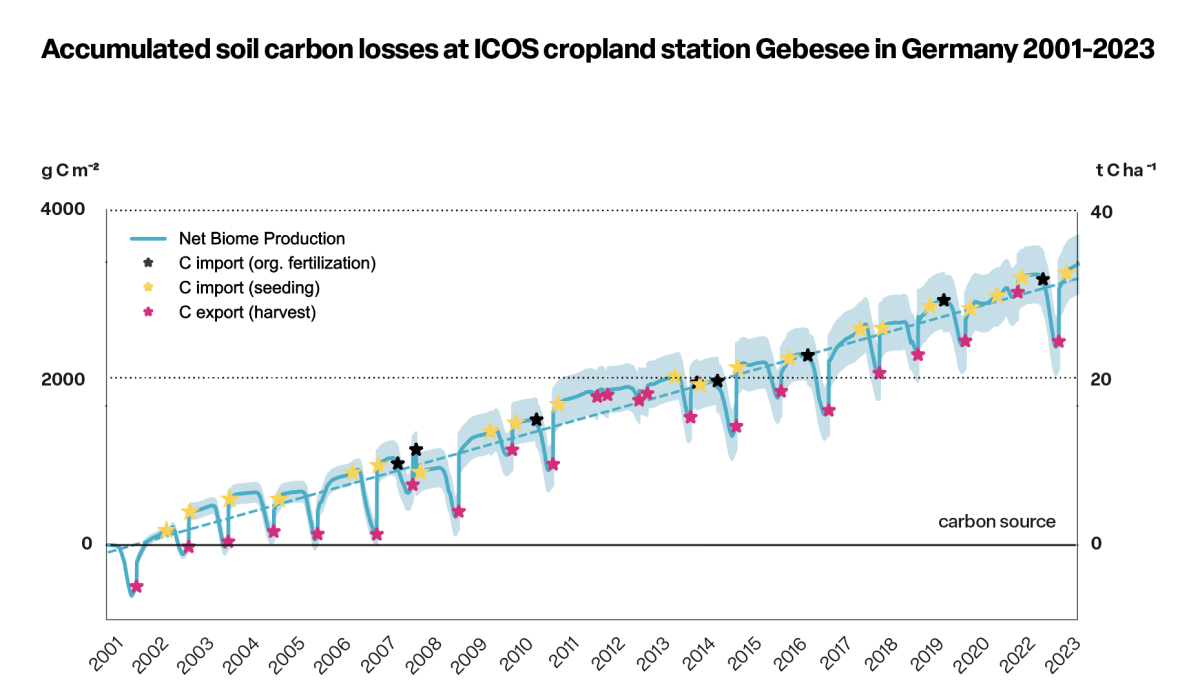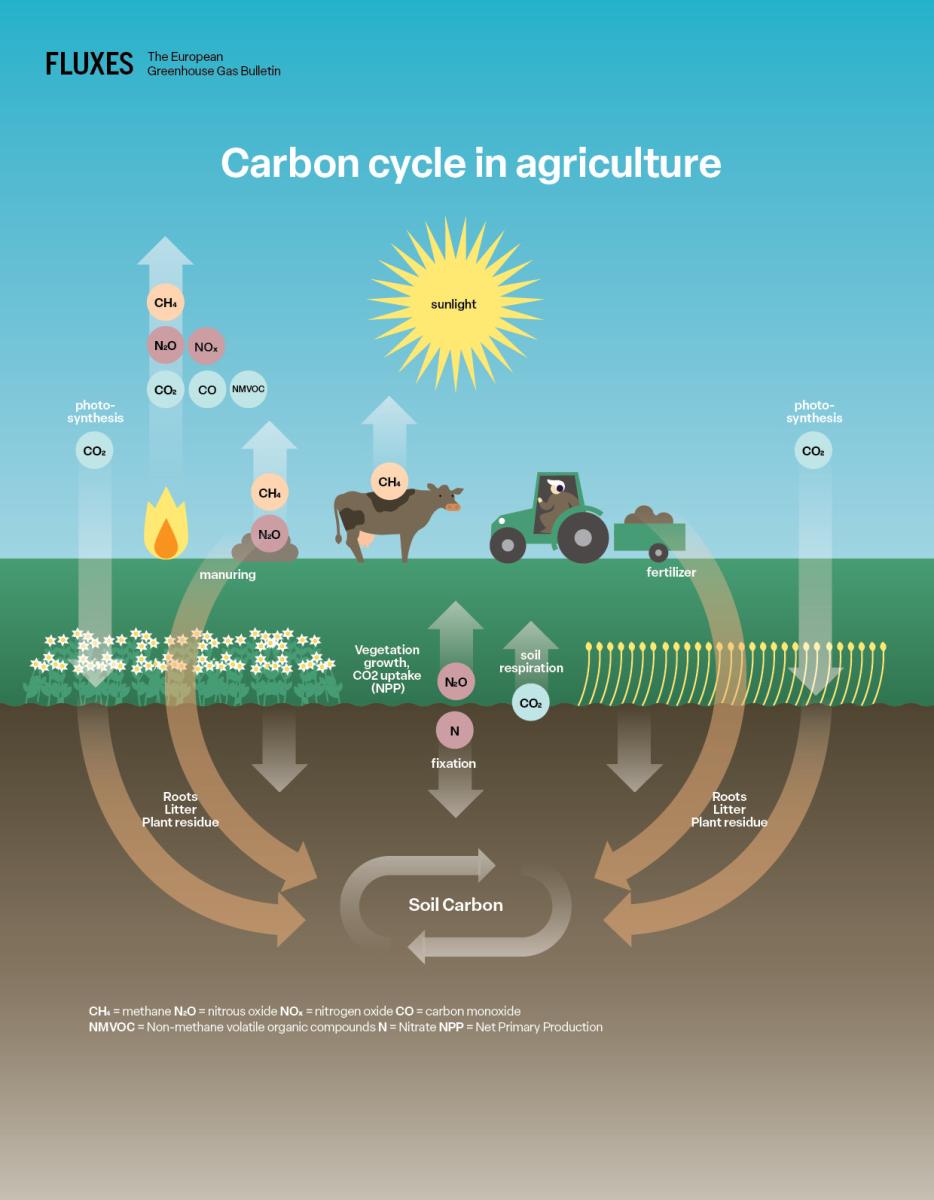
Agriculture causes about 11% of the European Union's greenhouse gas emissions1. The share is noteworthy because the two major emissions – nitrous oxide and methane – are very powerful greenhouse gases. Farming methods which tackle agricultural emissions are often referred to as carbon farming. This article discusses the role of agricultural soils in carbon farming, since only soils can be part of nature-based climate solutions.
The new EU regulation on Carbon Removal Certification defines carbon farming as storing carbon in the soil and vegetation, such as bushes or trees, in order to mitigate climate change. However, ICOS scientists, most environmental organisations, and even some EU bodies argue that other benefits that an increased soil carbon stock will bring are equally important. These benefits consist, for example, of improved biodiversity improved biodiversity and soil health, resistance to droughts through improved water holding capacity, improved food security through better yields and thus better profitability of the farm. This wider approach could also be called regenerative agriculture or sustainable farming.
“Carbon farming transforms our agroecosystems to more efficient and resilient ecological platforms, able to face the new challenges brought by climate change,” explains Dr Claire Chenu, Director of Research at the INRAE and Professor of Soil Science at AgroParisTech. “In essence, carbon farming aims to increase the yields by improving the condition of soils. Possible carbon sequestration is a by-product of that,” she continues.
Soils are the only farming emission sources that could become sinks
All industries and sectors need to reduce emissions to reach the European Union’s 55% reduction target. In the emission inventories that countries provide to the United Nations Climate Change Convention (UNFCCC), the food production emissions are divided between several sectors. In the agricultural sector, over half of the emissions are caused by the livestock farming: rumination of cattle and sheep as well as the management of their manure cause methane (CH4) emissions, while nitrogen fertilisation in crop production causes nitrous oxide (N2O) emissions which are the second big part of agricultural emissions. The total emissions from the EU agricultural sector amount to 400 million tonnes of carbon dioxide equivalents (CO2e), as seen in the figure 1.¹

Carbon dioxide emissions from agricultural lands, on the other hand, are included in the so called LULUCF (emissions from land use, land-use change and forestry) sector. Croplands and grasslands lose about 40 million tonnes of CO2 every year, mainly from soils containing organic matter e.g. derived from plants, animals and micro-organisms. The soils naturally respire CO2, but due to removing the plants after harvests, this carbon is not replaced back to the soils. Ploughing and other tillage actions increase soil respiration as discussed later in this article.
Due to the high rate of emissions from the animals, it is practically impossible for livestock farming to become carbon neutral, although a possible reduction in livestock animals will decrease the emissions. While agricultural lands are also currently net CO2 sources, soils could in theory be carbon sinks and thus be a part of the nature-based climate solutions.
Organic matter keeps soils healthy
Plants take up CO2 from the atmosphere to grow, but they also need sunlight, nutrients and water for growth. The nutrients are in the soil, many of them tightly linked in the soil organic matter. Put simply, the more organic matter in the soil, the greater the nutrient availability for the plants. “Soil contains microbes that use organic carbon and nitrogen as their energy source, and change the organic matter to a suitable form for plants to use. This microbial process is called mineralisation, and it also releases carbon dioxide and nitrogen oxide into the atmosphere,” explains Dr Ivan Janssens, Plants and Ecosystems professor at the University of Antwerp.
Since microbes mineralise the organic matter and with that unlock nutrients for plants, the soil loses carbon. In natural ecosystems, the lost soil organic matter is replaced by litter, but in agricultural ecosystems the plants are harvested and the carbon is taken away. This leads to a depletion of organic matter in those soils.
Additionally, tillage and other land management actions in croplands disturb the soil structure, which benefits some microbes, while disturbing others. “We see an increase of carbon dioxide released from the soil to the atmosphere for weeks after a management action, particularly after full harvest when all vegetation is removed,” explains Dr Christian Brümmer, the Focal Point of ICOS Germany and researcher at the Thünen Institute of Climate-Smart Agriculture. Soil and nutrients are also removed from the fields by wind and rainfall, through erosion.
Because the microbial processes are not fast or plentiful enough to provide sufficient nutrients for plants, agricultural soils are usually fertilised regularly to keep the yields at sufficient levels. Fertiliser can contain organic matter such as manure, compost or non-edible plant materials left to the ground after harvest. However, quite often mineral fertilisers applied mainly consist of inorganic nitrogen, phosphorus and potassium. Using the mineral fertilisers will result in environmental problems such as lower carbon stocks in the soil, and more nitrous oxide (N2O) released from soil into the atmosphere. N2O is estimated to be about 300 times more potent a greenhouse gas than CO2. Moreover, excess nitrogen amounts often leach into aquatic ecosystems, causing e.g. toxic algal blooms and threatening aquatic life and polluting drinking waters.
Agricultural soils in Europe are losing carbon
Currently, croplands and grasslands release more carbon dioxide than they take up, as stated by the EU inventories.² Furthermore, the EU's Joint Research Centre estimates that at least 60% of the soils in the Union are generally in poor condition: they are low in carbon, contain too many nitrates, or suffer from erosion or compaction. All these problems relate to low organic matter content in the soil.³
A recent joint study by the ICOS community in Germany presented long-term data of carbon fluxes in agricultural ecosystems. The group measured the net uptake of the ecosystems by a method called eddy covariance, and also monitored the import and export of carbon by harvest and manure. The result is called net biome production (NBP). The group showed that both cropland and grassland soils lose carbon year after year, despite regular organic fertilisation. The figure 3 illustrates the severity of the situation.⁴

“We are really alarmed and surprised by these results because our findings differ from the commonly used methods of repeated stocktake which often show that the soil organic carbon pool is stable,“ says Christian Brümmer, coordinator of the study as the the ICOS Germany Focal Point. The group is currently analysing the data in depth. Colleagues in other ICOS countries have found similar results and the carbon losses were supported by repeated stocktake. The standardised measurement techniques of ICOS make the comparison of the results easy and reliable. The reasons for the carbon losses may be explained by recent changes in management or by global warming that enhances the mineralisation.
The LULUCF regulation aims to increase the land carbon sinks, so the Commission proposes the Carbon Removal Certification as an incentive system for the land managers.
-Dr Lucia Perugini, member of the Expert Group on Carbon Removals of the European Commission.
Measures that reduce carbon losses or even increase the carbon in the soils include improved manure management, more precise nitrogen inputs, and improved soil management, with inter-cropping and cover crops as well as protecting soils rich with organic matter, by rewetting peatlands not currently in use.⁵ However, any increased carbon sequestration from these actions can compensate only a few percents of agricultural emissions, according to the ICOS scientists. They are not a long-term solution for the climate crisis.
But they bring other significant benefits. More organic matter in the soil gives a better water-holding capacity, which in turn makes croplands and grasslands more resistant to droughts. It reduces the need for mineral fertilisers, decreasing groundwater pollution and greenhouse gas emissions caused by excess nitrogen. More efficient manure management can solve several issues: waste management, nutrients to the soil, and energy supply in the form of biogas. All this needs to be organised in a way that overcomes existing or perceived conflicts between environmental measures, food security and the economic sustainability of farmers.
Dr Chenu points out that farmers are the key: “Farmers should be financially rewarded for the multiple benefits they provide. Potential carbon sequestration is only one benefit of healthier soils. They also contribute to better climate resilience, increased biodiversity, improved water quality, and food security”.

Carbon removal certification is no silver bullet solving climate crisis
One way of rewarding the farmers could be the new Carbon Removal Certification system currently being prepared by the EU. Besides technological solutions, it also includes forestry and agriculture.
“The new LULUCF regulation puts pressure to increase the land-based carbon sinks, so the EU Commission proposes the certification as an incentive system for the land managers,” explains Dr Lucia Perugini, Senior Scientific Manager at the CMCC in Italy.
This voluntary system would include criteria for additional, long-term removal of carbon, the quantification of the amounts, and the sustainability of removal practices. The Commission proposes to establish a common monitoring standard. The certificates would be part of the already existing voluntary carbon market, as a trading element and worth money for the farmer. The proposal currently presents mainly principles, and leaves many essential parts open, to be developed after the general regulation has been accepted by the European Parliament.
There is currently no European-wide standard for measuring or accurately estimating soil organic carbon. It also is difficult to measure small changes reliably, and to see any increase takes many years. “If I take a soil sample and send it to ten laboratories in Europe, I will get ten different answers,” says Ivan Janssens. “The laboratories use different methodologies and instruments that are calibrated differently, which brings highly variable results.”
Indeed, a transparent and standardised system must be put in place for the Carbon Removal Certification regulation to work. “The regulation says that carbon removals need to be based on measurements and quantified, but the methodologies are still under development,” explains Perugini, who is a member of the Expert Group established by the Commission for that development.
ICOS has great potential for this work, Perugini says: “ICOS can help us to understand what are the effects of different management systems and practises in different conditions. For instance, how much cover crops affect the carbon sink, or what is the magnitude of possible side-effects. ICOS could also develop a baseline for certain type of soil or forest sinks. When the sinks are certified, they undergo a verification process to check whether the results are within the acceptable ranges. ICOS could provide external verification information.”
Dr Perugini ponders that ICOS could participate in building an emission factor repository on the changes in agricultural practices, to provide data for the farmers for their decision-making. “And certainly, ICOS can help greatly to understand the year-to-year and seasonal variations caused by weather to the soil carbon dynamics. Even though the farmer would do everything by the book for five years, but then comes a very dry year destroying yields and carbon values. Then what happens?”
The permanence of the increased soil carbon stock is one of the key issues, as it is highly uncertain. It depends very much on weather variability, and on the future actions of the land managers.

Proper monitoring and verification needs a combination of ground-based and satellite data, modelling and inventories
For Ivan Janssens, the ICOS focal point for Belgium, a robust and dense ground-based observation network is an essential part of a new data value chain for carbon farming: “ICOS is the leading European research infrastructure with standardised measurement and data processing protocols.” The ground-based data from ICOS enables modellers to verify and better calibrate the satellite data, and thus make more accurate climate predictions.
If we want a reliable monitoring, reporting and verification system, we need all components: ground-based data, remote sensing, modelling and inventory analyses.
Dr Ivan Janssens, ICOS Belgium, Professor at the University of Antwerp
Models are important because neither ground-based nor satellite observations can cover all possible soil types and geographical variations all the time, the scientists say. If we want a reliable monitoring, reporting and verification system, we need all components working together: ground-based data, remote sensing, modelling and inventory analyses.
Dr Elisa Vainio from Baltic Sea Action Group foundation was also interviewed for this article, and Prof. Nina Buchmann and Dr Werner Kutsch have contributed to it.
References
1 European Environmental Agency (2022): Greenhouse gas emissions from land use, land use change and forestry in Europe https://www.eea.europa.eu/ims/greenhouse-gas-emissions-from-land
2European Environmental Agency (2022) Historical (1990-2020) and projected (2020-2040) emissions from the agriculture sector in the EU-27 https://www.eea.europa.eu/data-and-maps/figures/historical-1990-2020-and-projected
3Joint Research Center (2023): EUSO Soil Health Dashboard. https://esdac.jrc.ec.europa.eu/esdacviewer/euso-dashboard/
4Brümmer, C., Schrader, F., Kolle, O., Herbst, M., Lucas-Moffat, A., and Kutsch, W. (2023): The enigma of a massive carbon imbalance – Two decades of cropland eddy flux measurements at Gebesee, Thuringia, Germany, EGU General Assembly 2023, Vienna, Austria, 24–28 Apr 2023, EGU23-15905, https://doi.org/10.5194/egusphere-egu23-15905, 2023.
5FAO and ITPS (2021). Recarbonizing Global Soils - A technical manual of recommended sustainable soil management. Volume 3: Cropland, Grassland, Integrated systems, and farming approaches - Practices Overview. Rome. https://doi.org/10.4060/cb6595en
6McDonald, H., Frelih-Larsen, A., Lóránt, A.et al., (2021) Carbon farming – Making agriculture fit for 2030, European Parliament, 2021, https://data.europa.eu/doi/10.2861/099822
7Figure 5.12 in IPCC, 2021: Chapter 5. In: Climate Change 2021: The Physical Science Basis. Contribution of Working Group I to the Sixth Assessment Report of the Intergovernmental Panel on Climate Change, doi: 10.1017/9781009157896.007
Data citations
Figure 3. Brümmer, C., Schrader, F., Kolle, O., Herbst, M., Lucas-Moffat, A., Kutsch W.L. (2023) The enigma of a massive carbon imbalance – Two decades of cropland eddy flux measurements at Gebesee, Thuringia, Germany. EGU General Assembly 2023, https://doi.org/10.5194/egusphere-egu23-1590
